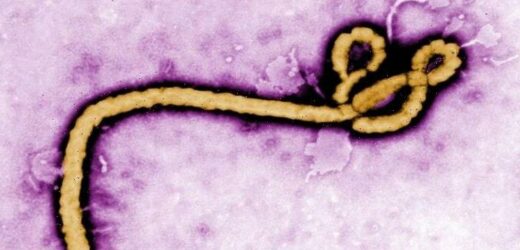Ebola: Guinea Health Agency declares 'pandemic' in February
We use your sign-up to provide content in ways you’ve consented to and to improve our understanding of you. This may include adverts from us and 3rd parties based on our understanding. You can unsubscribe at any time. More info
The research’s conclusions could be crucial in changing how Ebola virus outbreaks are handled, and see long-term monitoring of the survivors of the disease reassessed. The researchers found the Ebola virus remained in the brain after successful treatment of the disease, whereas it would be absent from other organs.
The study, carried out by the US Army Medical Research Institute of Infectious Diseases, concentrated on the relatively murky medical field of the pathology of recurring disease.
They used a monkey disease model, as the disease often presents similarly in humans.
They zoned in on where the virus lurks within the human body.
How the disease recurs in recovered patients was a little-known area, although some recent Ebola outbreaks in Africa have been linked to patients who were previously infected, but then recovered from the disease.


Two monkeys in the study recovered from disease caused by Ebola after treatment with antibody therapeutics, but then were re-infected.
Scientists said “massive Ebola virus infection” and inflammation was found in the monkeys’ brain ventricular systems.
However, no trace of pathology or infection was detected in other organs.
Senior study author, Xiankun (Kevin) Zeng, described how the Ebola virus was limited to the brain after the recurrence of infection.

He said: “We found that about 20 percent of monkeys that survived lethal Ebola virus exposure after treatment with monoclonal antibody therapeutics still had persistent Ebola virus infection – specifically in the brain ventricular system, in which cerebrospinal fluid is produced, circulated, and contained – even when Ebola virus was cleared from all other organs.”
He added: “Ours is the first study to reveal the hiding place of brain Ebola virus persistence and the pathology causing subsequent fatal recrudescent Ebola virus-related disease in the nonhuman primate model.”
Jun Lui, another co-author of the study, said the disease relapse in the long-term recovered could trigger new outbreaks.
They added: “The persistent Ebola virus may reactivate and cause disease relapse in survivors, potentially causing a new outbreak.”
DON’T MISS:
Boris Johnson LIVE: Tory scandal explodes as MPs rage [LIVE]
Prince Charles has big choice to make – will he snub Buckingham Palace [INSIGHT]
Boris Johnson: PM broke law! Remoaner O’Brien sparks row [REPORT]

The findings emphasise the need to watch Ebola survivors more closely in order to head off any infection re-emergence in their organs.
Dr Zeng said: “This will serve to reduce the risk of disease re-emergence, while also helping to prevent further stigmatisation of patients.”
Ebola is one of the most lethal infectious diseases to humans.
It has an average mortality rate of 50 percent, but ranges from 25 percent to 90 percent when judged on fatality rates from cases of previous outbreaks.
In 2021 alone, three outbreaks of Ebola were recorded, and it continues to threaten the lives of people across Africa.
The Ebola Virus Disease is spread through direct contact with an infected animal, or a human who has contracted the virus.
For those infected with Ebola, symptoms can present within two to 21 days after contact.
Those suffering from disease caused by the Ebola virus can experience fever, loss of appetite, severe headaches, sore throats, and unexplained bleeding or bruising.
Source: Read Full Article


